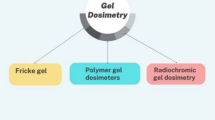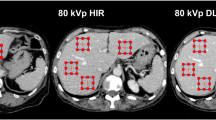Abstract
This study aimed to determine the mean fetal doses for patients who underwent computed tomography (CT) and/or conventional X-ray (CXR) examinations. In addition to develo** an approach to estimate the fetal dose based on data registered in the picture archive and communication system (PACS), the radiation doses for pregnant women and their fetuses were estimated using the VirtualDoseCT and VirtualDoseIR softwares. To verify the data, the fetal dose was measured using thermoluminescent dosimeters (TLDs) implanted at different uterus sites of an anthropomorphic pregnant phantom. Calculated fetal dose values were estimated in relation to the dose-area product (DAP) and volume CT dose index (CTDIvol). DAP and CTDIvol were obtained from data registered in the PACS. The fetal doses varied between < 0.001 and 3.9 mGy and between 0.26 and 16.21 mGy for the CXR and CT examinations, respectively. These values were similar to those of previous studies on both imaging modalities. The conversion factors obtained to calculate fetal doses for CXR examinations were between 0.01 and 0.73 mGy/Gy cm2, whereas they varied between 0.02 and 0.61 mGy/mGy for CT examinations. Overall, the fetal dose conversion factors based on DAP and CTDIvol values can be used for fast fetal dose estimations in common CXR and CT examinations.



Similar content being viewed by others
References
International Commission on Radiological Protection (ICRP), Biological Effects after prenatal irradiation (embryo and fetus), ICRP publication 90, Oxford: Pergamon 2003;33:1–2.
International Commission on Radiological Protection (ICRP), The 2007 recommendations of the international commission on radiological protection, ICRP publication 103, Oxford: Pergamon 2007; 37:2–3.
National Radiological Protection Board (NRPB), Statement by the National Radiological Protection Board: diagnostic medical exposures: advice on exposure to ionizing radiation during pregnancy, Documents of the NRPB 1993; 4(4):1–3
International Commission on Radiological Protection (ICRP), Pregnancy and Medical Radiation, ICRP publication 84, Oxford: Pergamon 2000;30(1).
Kettunen A. Radiation dose and radiation risk to foetuses and newborns during x-ray examinations. STUK-Radiation and Nuclear Safety Authority, STUK-A204 Helsinki, 2004.
Damilakis J, Perisinakis K, Voloudaki A, Gourtsoyiannis N. Estimation of fetal radiation dose from computed tomography scanning in late pregnancy. Invest Radiol. 2000;35(9):527–33.
Osei EK, Faulkner K. Fetal doses from radiological examinations. Brit J Radiol. 1999;72:773–80.
Nagel HD. Radiation exposure in computed tomography, fundamentals, influencing parameters, dose assessment, optimisation, scanner data, terminology. CTB Publications; D-21073, Hamburg, 2002.
Adams EJ, Brettle DS, Jones AP, Hounsell AR, Mott DJ. Estimation of fetal and effective dose for CT examinations. Br J Radiol. 1997;70:272–8.
Osei EK, Darko J. Foetal radiation dose and risk from diagnostic radiology procedures: a multinational study. ISRN Radiol; 2013 (1), Article ID 318425.
Ding A, Gao Y, Liu H, Caracappa PF, Long DJ, Bolch WE, Liu B, Xu XG. VirtualDose: a software for reporting organ doses from CT for adult and pediatric patients. Phys Med Biol. 2015;60(14):5601–25.
International Commission on Radiological Protection (ICRP), Diagnostic reference levels in medical imaging, ICRP Publication 135, Ann. ICRP 46(1), 2017.
Helmrot E, Pettersson H, Sandborg M, Altén JN. Estimation of dose to the unborn child at diagnostic X-ray examinations based on data registered in RIS/PACS. Eur Radiol. 2007;17:205–9.
Kalender WA, Schmidt B, Zankl M, Schmidt M. A PC program for estimating organ dose and effective dose values in computed tomography. Eur Radiol. 1999;9:555–62.
Tapiovaara M, Lakkisto M, Servomaa A. PCXMC, APC-based Monte Carlo program for calculating patient doses in medical x-ray examinations. 1997; STUK-A139.
Ding A, Gao Y, Caracappa PF, Liu B, Long D, Bolch WE, Xu XG. Testing of CT Dose Software VirtualDose<™ for Tracking and Reporting Patient Doses. 2012 RSNA Annual Meeting, Chicago, 2012.
Saeed MK. A comparison of the CT-dosimetry software packages based on stylized and boundary representation phantoms. Radiography. 2002;26(4):e214–22.
Sadro C, Bernstein MP, Kanal KM. Imaging of trauma. Part 2. Abdominal trauma and pregnancy: a radiologist’s guide to doing what is best for the mother and baby. AJR. 2012;199:1207–19.
Pi Y, Feng M, Qi Y, Gao Y, Caracappa PF, Chen Z, Xu XG. VirtualDose-IR: a cloud-based software for reporting organ doses in interventional radiology. Phys Med Biol. 2019;64(9):095012.
ATOM. Adult female phantom handling instructions, CIRS tissue simulation technology, 2428 Almeda Avenue, Suite 212, Norfolk, Virginia 23513, USA, 2002.
International Commission on Radiological Protection (ICRP), Adult reference computational phantoms, ICRP Publication 110 Ann, ICRP 39, 2009.
International Commission on Radiation Units and Measurements (ICRU), Photon, Electron, Proton and Neutron Interaction Data for Body Tissues, ICRU Report 46. ICRU, 1992.
Osei EK, Faulkner K. Radiation risks from exposure to diagnostic X-rays during pregnancy. Radiography. 2000;6:131–44.
Shrimpton PC, Wall BF, Jones DG, Fisher ES, Hillier MC, Kendall GM, Harrison RM. A national survey of doses to patients undergoing a selection of routine X-ray examinations in English hospitals, NRPB-R200. 1896; London: HMSO.
HPA, RCE-9. Protection of pregnant patients during diagnostic medical exposures to ionising radiation: advice from the health protection agency, The Royal College of Radiologists and the College of Radiographers; 2009.
Health Canada. Diagnostic x-rays and Pregnancy, http://www.hc-sc.gc.ca/english/iyh/medical/x_rays.html 2003 Accessed 21 March 2020.
Pataramontree J, Wangsuphachart S, Apaiphonlacharn J, Chiachan P, Sompradit S, Suteerakul K, Thamwerawong W. Patient and fetal dose in diagnostic x-rays and radiotherapy in Bangkok, Thailand. Proc. International Atomic Energy Agency (IAEA). Radiological protection of patients in diagnostic and interventional radiology, nuclear medicine and radiotherapy, Vienna, 2001; 527 -53.
Toppenberg KS, Hill DA, Miller DP. Safety of radiographic imaging during pregnancy. Am Fam Physician. 1999;59:1813–8.
Wieseler KM, Bhargava P, Kanal KM, Vaidya S, Stewart BK, Dighe MK. Imaging in pregnant patients: examination appropriateness. Radiographics. 2010;30(5):1215–29.
Sharp C, Shrimpton JA, Bury RF. Diagnostic Medical Exposures: advice on exposure to ionizing radiation during pregnancy. Chilton: National Radiological Protection Board College of Radiographers and Royal College Radiologists; 1998.
Osei EK, Darko JB, Faulkner K, Kotre CJ. Software for the estimation of foetal radiation dose to patients and staff in diagnostic radiology. Radiol Prot. 2003;23:183–94.
International Commission on Radiological Protection (ICRP), Basic anatomical and physiological data for use in radiological protection: reference values, ICRP Publication 89, 2001; 22:1–277.
Acknowledgements
The authors are grateful to the Deanship of Scientific Research at Najran University for funding this research (Project no. NU/MID/16/009).
Author information
Authors and Affiliations
Corresponding author
Ethics declarations
Ethical approval
All procedures performed in studies involving human participants were in accordance with the ethical standards of the institutional and/or national research committee and with the 1964 Helsinki declaration and its later amendments or comparable ethical standards.
Disclosure of conflict
The authors have no relevant conflicts of interest to disclose.
Additional information
Publisher's Note
Springer Nature remains neutral with regard to jurisdictional claims in published maps and institutional affiliations.
About this article
Cite this article
Saeed, M.K. Comparison of estimated and calculated fetal radiation dose for a pregnant woman who underwent computed tomography and conventional X-ray examinations based on a phantom study. Radiol Phys Technol 14, 25–33 (2021). https://doi.org/10.1007/s12194-020-00598-9
Received:
Revised:
Accepted:
Published:
Issue Date:
DOI: https://doi.org/10.1007/s12194-020-00598-9




